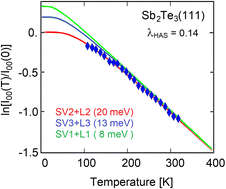The role of high-energy phonons in electron–phonon interaction at conducting surfaces with helium-atom scattering
Abstract
In previous works it has been shown that the Debye–Waller (DW) exponent for Helium atom specular reflection from a conducting surface, when measured as a function of temperature in the linear high-temperature regime, allows for the determination of the surface electron–phonon coupling. However, there exist a number of experimental measurements that exhibit non-linearities in the DW exponent as a function of the surface temperature. Such non-linearities have been suggested as due to vibrational anharmonicity or a temperature dependence of the surface carrier concentration. In this work, it is suggested, on the basis of a few recent experimental data, that the deviations from linearity of the DW exponent temperature-dependence, as observed for conducting surfaces or supported metal overlayers with the present high-resolution He-atom scattering, permit to single out the specific role of high-energy phonons in the surface electron–phonon mass-enhancement factor.

- This article is part of the themed collections: Festschrift Wolfgang E. Ernst: Electronic & Nuclear Dynamics in Molecules, Clusters, and on Surfaces and 2022 PCCP HOT Articles


 Please wait while we load your content...
Please wait while we load your content...